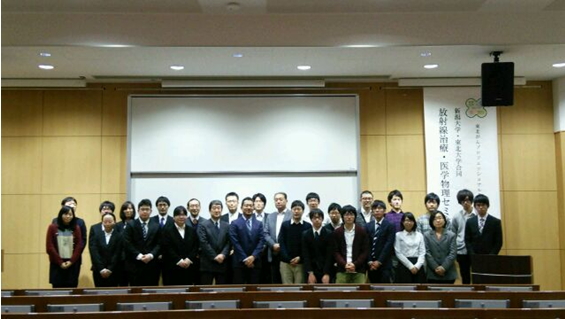2016.1.30:The Nigata University – Tohoku University joint radiation therapy seminar
The Nigata University – Tohoku University joint radiation therapy seminar has been held in Niigata University, Niigata, Japan.
■Date: 2016.1.30
■Venue: Niigata University , Niigata, Japan
■Conference name: Nigata University – Tohoku University joint radiation therapy seminar

Kengo Ito(Assistant professor)
We are pleased to report that we participated in the joint Niigata University-Tohoku University Seminar on Radiation Therapy and Medical Physics held at Niigata University on Saturday, January 30. From Tohoku University, 12 members of the Medical Physics Group (3 staff, 4 doctoral students, and 5 pre-doctoral students) and 4 physicians, a total of 16 people, made up a very large group, participated in the seminar.
The venue of the seminar, Niigata University School of Medicine, is my alma mater from which I graduated, and I was very much looking forward to this seminar. At the seminar, we reported to each other on the current status and research results of each medical physicist training course at Tohoku University and Niigata University.
The Niigata University professors reported on the performance evaluation of CAD for CT lung cancer by applying convolution and deconvolution. This was a research on the subject that I was involved in my graduation research when I was a student at Niigata University. While I missed it, I realized that I did not have a deep understanding of it at that time. In addition, he reported many other researches that are different from the characteristics of our laboratory, such as dose evaluation by backscattering of dental metals using Monte Carlo simulation and visualization of the effect of TPS registered values of MLC parameters on dose distribution, and I spent very valuable and meaningful time with him.
From Tohoku University, we reported on the combined dose evaluation using Deformable Image Registration, the estimation of actual patient dose distribution using EPID, the reevaluation of FDG-PET SUVmax as a prognostic factor, and DVH-based patient QA. I reported on the treatment planning using MRI images.
I reported on treatment planning using MRI images. Although I could only report negative results, I was able to receive many questions and opinions from the Niigata University professors, and I was able to make valuable discoveries that I can apply to my future research.
Finally, I would like to take this opportunity to thank the secretariat of the Tohoku Cancer Professional Development Plan, which hosted the conference, the members of the Medical Physics Group at Niigata University, and Professor Aoyama for providing us with such a valuable opportunity for study.
